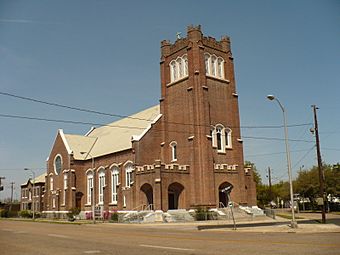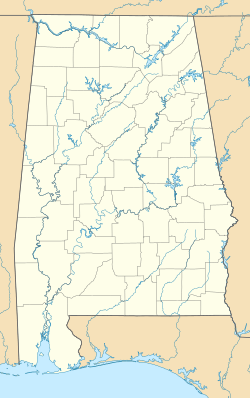Saint Joseph's Roman Catholic Church (Mobile, Alabama) facts for kids
Quick facts for kids |
|
|
Saint Joseph's Roman Catholic Church
|
|

Saint Joseph's Roman Catholic Church in 2008.
|
|
| Location | Mobile, Alabama |
|---|---|
| Built | 1907 |
| Architect | Diboll & Owen; Chamblin, G.A. |
| Architectural style | Gothic Revival |
| MPS | Historic Roman Catholic Properties in Mobile Multiple Property Submission |
| NRHP reference No. | 91000841 |
| Added to NRHP | July 3, 1991 |
Saint Joseph's Roman Catholic Church was a special old church building in Mobile, Alabama, United States. It served as a place of worship for St. Joseph's Parish, which was part of the Roman Catholic Archdiocese of Mobile.
St. Joseph's Parish was one of the oldest church groups in Mobile. It started in 1857 to help Catholics who lived too far from the main Cathedral downtown or the Church of St. Vincent de Paul. The parish served its community for almost 160 years before it closed in 2018.
Contents
History of the Church
Founding and Early Leaders
In 1857, Bishop Michael Portier chose a Jesuit priest named Father Peter Ismand to be the first leader of St. Joseph Parish. Father Peter Ismand was a well-liked priest. He helped soldiers from both sides during the American Civil War. He also worked hard to help people during the Yellow Fever sickness.
Sisters of Mercy and Education
The Sisters of Mercy, a group of religious women, came to Mobile in 1884 to help St. Joseph's Parish. They visited people who were sick, poor, and even prisoners. They also started St. Joseph's School, which later became known as the Convent of Mercy Academy. The school moved to a different place in 1969.
Building a New Church
As more people joined the parish, a bigger church was needed. The land on Springhill Avenue was bought from the Prador family. The Jesuits from Spring Hill College were in charge of building the new church. They built it close to the city hospital in 1858.
The new parish was mostly made up of German immigrants. A beautiful church building was designed in the Gothic style. It had a tall main hall (called a nave) and amazing stained glass windows. The first stone was laid by Bishop Allen on August 8, 1907. The church was finished in about a year and was officially opened on August 4, 1908.
Church Organizations
In 1907, several groups were started by the church under the leadership of Father Linus Schuler. These included: The Altar Society, The Holy Name Society, St. Vincent de Paul Conference, The Society for Propagation of Faith, and The Holy Child Association. These groups helped the church and its community in many ways.
A "Handsome" Church
In September 1908, the Mobile Daily Register newspaper wrote about the newly finished church. They called it "one of the handsomest churches in the state." The newspaper noted that a special feature was the lack of columns inside, which made the interior "entirely open." The church could seat 800 people.
Changes in Management
The Jesuits continued to manage the church for many years. They also set up a special fund to help support the parish. In 2009, the Jesuits handed over the management of the church to the Archdiocese of Mobile.
Church Architecture
The architects for the church were Diboll and Owen from New Orleans, and G. A. Chamblin of Mobile was the builder.
Gothic Revival Style
The church building is a great example of the Gothic Revival style. This style looks back to the grand churches of the Middle Ages. The church was 60 feet wide and 100 feet long. It was made of brick with a granite base. It had a tall tower that reached 120 feet high. The building featured a pointed roof (gable) at the front, a central square tower, side sections (transepts), and a rounded end (apse).
Exterior Features
The front of the church is dominated by its tall tower. The tower has a main entrance with two wooden doors that have pointed, Tudor-style arches. Above the entrance, there's a decorative wall with battlements. The tower also has large support structures called buttresses. On the second floor, there are three stained glass windows, and on the third floor, there are three louvered vents.
The sides of the church have large, pointed Tudor-style stained glass windows, separated by buttresses. The transepts (side sections) also have buttresses and include pairs of tall Tudor windows with a large stained glass window above them. A copper cross sits on top of each transept.
Inside the Church
You enter the church through the tower. Double wooden doors and stained glass windows lead into the main worship area, called the sanctuary. The inside has a large main hall (nave) with four rows of pews and open transepts. The side walkways have low arches, and a high arch covers the nave. There are no columns supporting these arches, which makes the space feel very open. The walls are covered with marble up to a certain height. Beautiful stained glass windows, which were brought from Germany, are placed between the Stations of the Cross (pictures showing events in Jesus's final journey).
Lantern lights hang along each side of the nave. A marble rail separates the main seating area from the altar area at the west end. The apse (rounded end) has tall, decorative columns with golden tops on either side, and large columns behind them. The marble altar has a carving of the Last Supper, and the high altar is also made of marble with detailed carvings and spires.
Each transept has a large round stained glass window with a small space below it holding statues. A small, curved balcony above the main entrance holds organ pipes but no seating.
Closure of the Church
In 2017, the Archdiocese of Mobile, Alabama, announced that St. Joseph Church would close permanently after 109 years. The church was officially closed and sold in 2018. Many of the church's artworks were then moved and placed in the new St. Ignatius Church, which was being built at that time.
National Historic Significance
Saint Joseph's Roman Catholic Church was important because it kept its original look, materials, and design. The original decorative tops on the tower corners were damaged by Hurricane Frederic in 1979. However, there were no other major changes to the outside. The inside of the church also remained in excellent condition.
Saint Joseph's Roman Catholic Church is important because it is a great example of the Second Gothic Revival style in Mobile. Its high-quality design, materials, and craftsmanship were typical of Catholic church buildings in the city. The church was also special because its rectory (the priest's house) was built at the same time and matched the church's style very well. No other rectory in the city was so similar in architecture to its church.
The building was added to the National Register of Historic Places on July 3, 1991. This was part of a larger group of important Catholic properties in Mobile.



